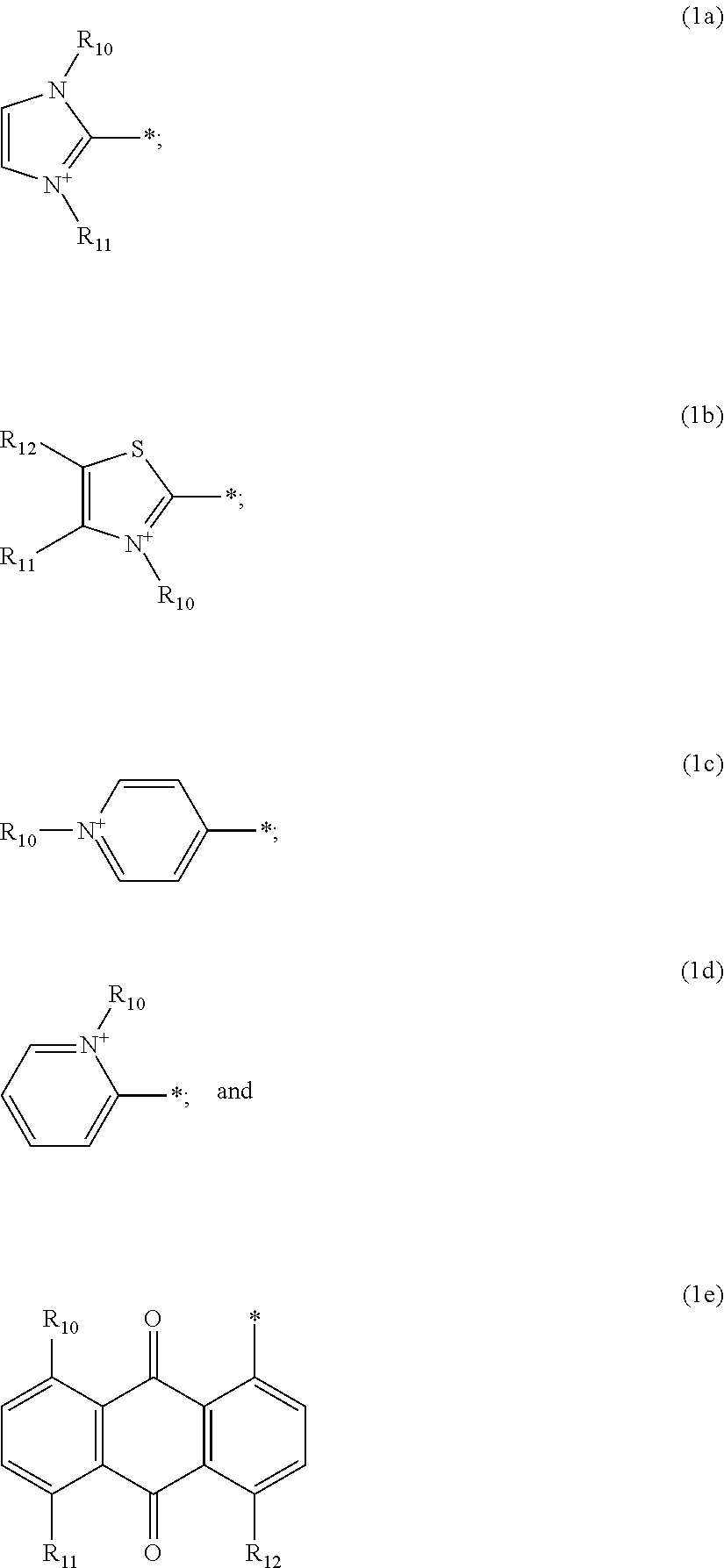Cationic direct dyes
a technology of direct dyes and cationic anchoring groups, applied in the field of cationic direct dyes, can solve the problems of difficult to produce dark shades, difficulty in producing dark shades, and difficulty in producing dyes with multiple cationic anchoring groups
- Summary
- Abstract
- Description
- Claims
- Application Information
AI Technical Summary
Benefits of technology
Problems solved by technology
Method used
Image
Examples
example 1
[0204]
a) Step 1: 4-[(E)-1H-imidazol-2-ylazo]-N,N-dimethyl-aniline
[0205]
[0206]20 g (0.105 mol) 2-((4-fluorphenyl)diazenyl)-1H-imidazole prepared according to literature (V. Eliu et al, WO2007025889) were suspended in 60 ml dimethylsulfoxide. To this suspension, 60 ml (0.532 mol) of an aqueous solution (40%) of dimethylamine was added within 10 minutes. The product mixture was heated to 80° C. and stirred at this temperature for 6 hours. Then the reaction solution was slowly cooled down to 20° C. A brown suspension was formed. The precipitate was filtered-off, washed with distilled water and dried at 40° C. at high vacuum.
[0207]Yield: 14 g, yellow solid.
[0208]1H NMR (DMSO-d6): δ=3.20 (s; 6H; 2×H3), 6.80, 7.20 and 7.78 (each m; 2H; Aryl-H), 12.5 (s, br, NH) ppm.
b) Step 2: 2-((E)-(4-(dimethylamino)phenyl)diazenyl)-1,3-bis(3-((((1,1-dimethylethyl)oxy)carbonyl)amino)propyl)-1H-imidazol-3-ium bromide
[0209]
[0210]13.2 g (0.061 mol) 4-[(E)-1H-imidazol-2-ylazo]-N,N-dimethyl-aniline prepared in...
example 2
Synthesis Scheme of Example 2
[0219]
a) Step 1 1,3-bis(3-(1,3-dioxo-1,3-dihydro-2H-isoindole-2-yl)propyl)-2-((E)-(4-fluorophenyl)diazenyl)-1H-imidazol-3-ium bromide
[0220]
[0221]To a mixture of 3.8 g (20 mmol) 2-((4-fluorphenyl)diazenyl)-1H-imidazole and 3.4 g (40 mmol) sodium bicarbonate in 80 ml of acetonitrile was added 16.1 g (60 mmol) N-(3-bromopropyl)phthalimide. The mixture was refluxed for 60 hours. The formed precipitate was removed by filtration and the filtrate was concentrated under reduced pressure. The resulting residue was applied to flash chromatography to yield intermediate as brown solid.
[0222]Yield: 4.2 g (33%).
b) Step 2: 1,3-bis(3-(1,3-dioxo-1,3-dihydro-2H-isoindol-2-yl)propyl)-2-((E)-(4-dipentylaminophenyl)diazenyl)-1H-imidazol-3-ium bromide
[0223]
[0224]To a mixture of 1.94 g (3 mmol) crude intermediate from example 2a), 4.5 g (1.5 mmol) sodium bicarbonate in 2.5 ml of acetone and 10 ml of water was added 0.566 g (3.6 mmol) dipentylamine. The mixture was stirred at 2...
example 3
Synthesis Scheme of Example 3
[0229]
a) Step 1: (E)-2-((4-(fluorphenyl)diazenyl)-1,3-di-pentyl-1H-imidazol-3-ium bromide (103a)
[0230]To a solution of 2.85 g (15 mmol) 2-((4-fluorphenyl)diazenyl)-1H-imidazole in 60 ml acetonitrile at 20° C. was added 3.78 g (45 mmol) sodium bicarbonate and 6.8 g (45 mmol) 1-bromopentane. The resulting reaction mixture was heated to reflux for 60 hours. The mixture was filtered to remove solid and the filtrate was concentrated under reduced pressure. The residue was purified to flash chromatography.
[0231]Yield: 1.6 g (25%), brownish solid.
[0232]1H NMR (MeOD): δ=0.93 (t; 6H, CH3), 1.43 (m; 8H, CH2), 1.97 (m; 4H, CH2), 4.61 (m; 4H, CH2), 7.48 (m; 2H, Aryl-H), 8.00 (s; 2H, Imidazoyl-H), 8.22 (d; 2H, Aryl-H) ppm.
b) Step 2: (E)-2-((4-(bis(3((((1,1-dimethylethyl)oxy)carbonyl)amino)propyl)phenyl)diazenyl)-1,3-di-pentyl-1H-imidazol-3-ium bromide
[0233]
I)
Synthesis of di-tert butyl.(azanediylbis(propane-3,1-diyl))dicarbamate (1,9-bis boc 1,5,9-triazanonane)
[0234]
[...
PUM
| Property | Measurement | Unit |
|---|---|---|
| temperature | aaaaa | aaaaa |
| temperature | aaaaa | aaaaa |
| temperature | aaaaa | aaaaa |
Abstract
Description
Claims
Application Information
 Login to View More
Login to View More - R&D
- Intellectual Property
- Life Sciences
- Materials
- Tech Scout
- Unparalleled Data Quality
- Higher Quality Content
- 60% Fewer Hallucinations
Browse by: Latest US Patents, China's latest patents, Technical Efficacy Thesaurus, Application Domain, Technology Topic, Popular Technical Reports.
© 2025 PatSnap. All rights reserved.Legal|Privacy policy|Modern Slavery Act Transparency Statement|Sitemap|About US| Contact US: help@patsnap.com



